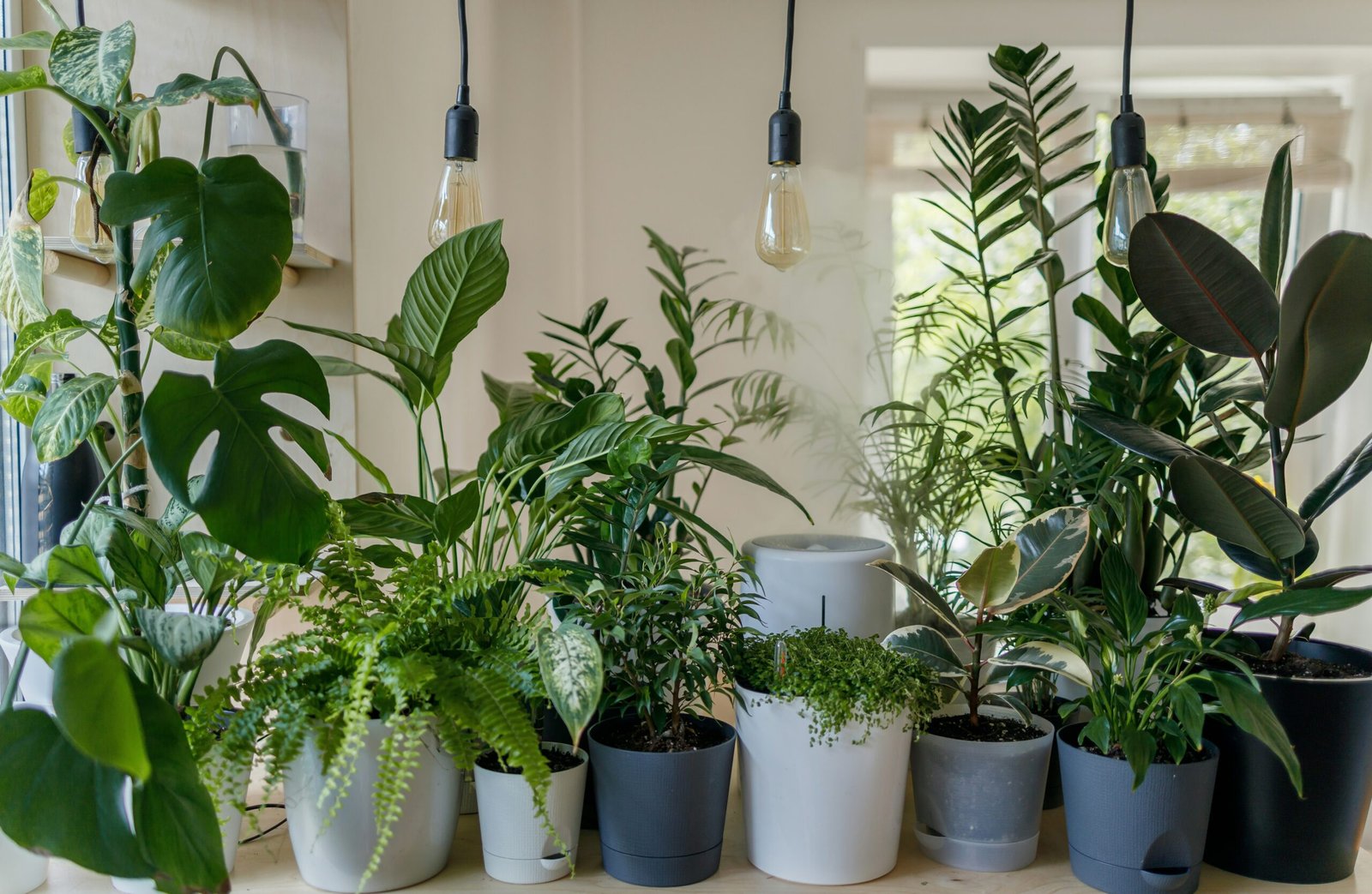How can you decorate your bedroom with plants?
How Can You Decorate Your Bedroom With Plants?
Adding plants to your bedroom can transform the space into a calming, healthier environment that reflects your personality. You’ll learn how to pick the right plants, place them for maximum effect, and care for them so they thrive and complement your décor.
Why Add Plants to Your Bedroom?
Plants boost mood, improve air quality, and add texture, color, and life to any room. You’ll find that even a few well-placed plants can soften hard lines, create focal points, and make your bedroom feel more restful.
What to Consider Before You Start
Before you bring plants home, consider light levels, available space, temperature, humidity, and whether you have pets or children. These factors will determine which plants will be easy for you to keep healthy and how you’ll arrange them.
Assessing Your Bedroom Environment
Understanding your room’s environment helps you choose plants that match the conditions rather than forcing plants into unsuitable spots.
Light Levels
Take note of how much natural light your bedroom gets during the day—bright direct light, bright indirect light, medium light, or low light. You can test this by observing where sunlight falls and for how long, or by using a light meter app.
Temperature and Humidity
Bedrooms are often cooler at night and warmer during the day. Note typical temperature ranges and whether the room is dry or humid. Plants such as ferns and calatheas prefer higher humidity, while succulents and cacti tolerate drier air.
Space and Layout
Measure window sills, shelf depth, and floor space so you can visualize where pots and stands will sit. Consider vertical options if floor space is limited.
Pets and Children
If you have pets or small children, choose non-toxic plants or place toxic plants out of reach. You’ll also want durable plants that can handle curious paws.
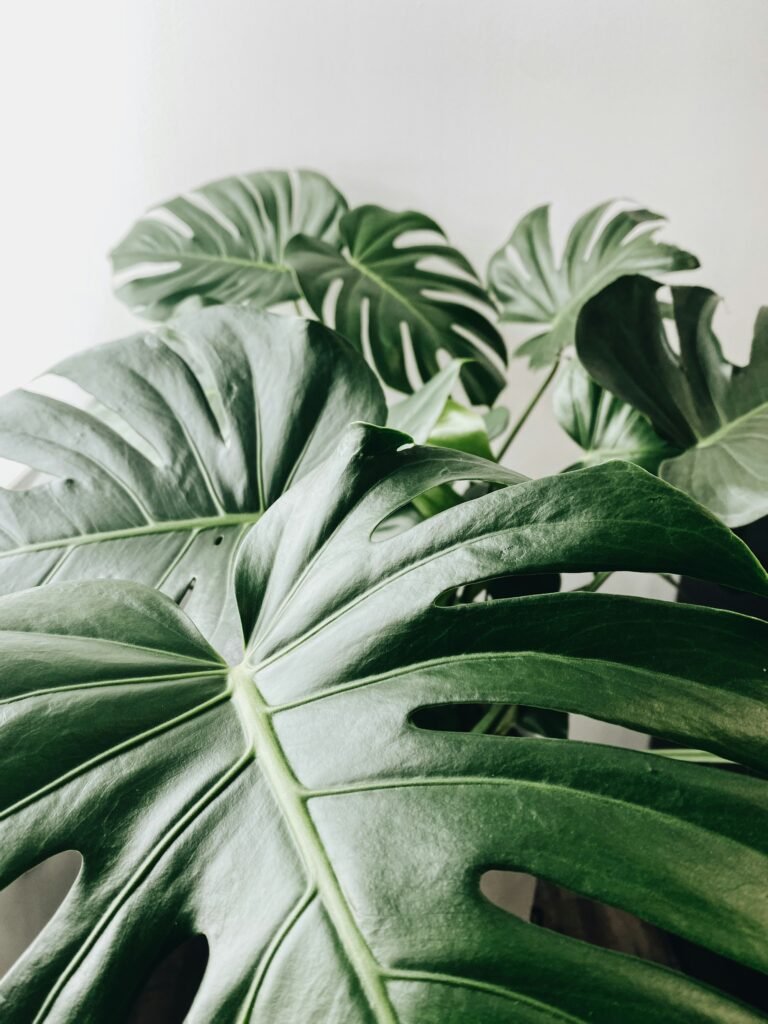
Choosing the Right Plants
Choosing plants by light, care level, and toxicity will save you time and frustration. Below is a practical list of common bedroom plants organized by light need and pet safety.
Recommended Plants by Light Level
Here’s a concise table to help you pick plants based on the light in your bedroom:
| Plant | Light | Water | Pet-Safe? |
|---|---|---|---|
| Snake Plant (Sansevieria) | Low–Bright | Low | No (toxic) |
| ZZ Plant (Zamioculcas) | Low–Bright | Low | No (toxic) |
| Pothos (Epipremnum aureum) | Low–Bright | Moderate | No (toxic) |
| Spider Plant (Chlorophytum comosum) | Low–Bright | Moderate | Yes |
| Peace Lily (Spathiphyllum) | Low–Medium | Moderate | No (toxic) |
| Philodendron (various) | Low–Bright | Moderate | No (toxic) |
| Rubber Plant (Ficus elastica) | Bright | Moderate | No (toxic) |
| Fiddle Leaf Fig (Ficus lyrata) | Bright | Moderate | No (toxic) |
| Succulents (Echeveria, Haworthia) | Bright direct | Low | Mostly Yes |
| Pilea (Pilea peperomioides) | Bright indirect | Moderate | Yes |
| Boston Fern (Nephrolepis exaltata) | Bright indirect | High | Yes |
| Calathea (various) | Medium | High | Yes |
| Aloe Vera | Bright | Low | No (toxic to pets if ingested) |
This table helps you match plants to your bedroom’s conditions and whether they’re safe around pets.
Low-Maintenance Picks
If you prefer low-effort plants, choose snake plant, ZZ plant, pothos, or succulents. These handle irregular watering and tolerate lower light.
Plants That Improve Humidity or Air Quality
If you’d like increased humidity or better air filtration, consider ferns, peace lily, spider plant, and areca palm. These plants release moisture and can help reduce airborne dust.
Placement and Composition
How you place and group plants affects both aesthetics and plant health. Plan arrangements that consider light, scale, and visual balance.
Bedside Plants
Small pots or hanging plants beside your bed can create a soft, inviting look. Choose compact plants like a small snake plant, pothos, or a small philodendron. Be mindful of water drainage on bedside tables—use trays or choose self-watering pots.
Windowsills and Window Ledges
Bright-loving varieties like succulents, aloe, and herbs do well on sunny windowsills. For windows with indirect light, place plants slightly away from the glass so they get gentle, filtered light.
Hanging and Trailing Plants
Hanging plants save floor space and create a layered, lush effect. Use pothos, string of hearts, spider plant, or ivy in hanging baskets or macramé planters. Make sure hanging plants have adequate light and are securely mounted.
Shelves and Bookcases
Mix plants with books and decorative items to add life to shelving. Use trailing plants to soften edges and top-heavy plants to provide vertical interest. Rotate plants occasionally to ensure even light exposure.
Floor Plants and Statement Pieces
Large plants like fiddle leaf fig, rubber plant, or a tall palm create statement corners. Place these in empty corners or near seating to anchor the room. Consider the plant’s mature size before buying.
Nightstand Safety and Scent Considerations
Keep highly fragrant plants or those that attract insects away from your sleeping area unless you enjoy their scent. Also keep toxic plants away from nightstands if children or pets climb surfaces.
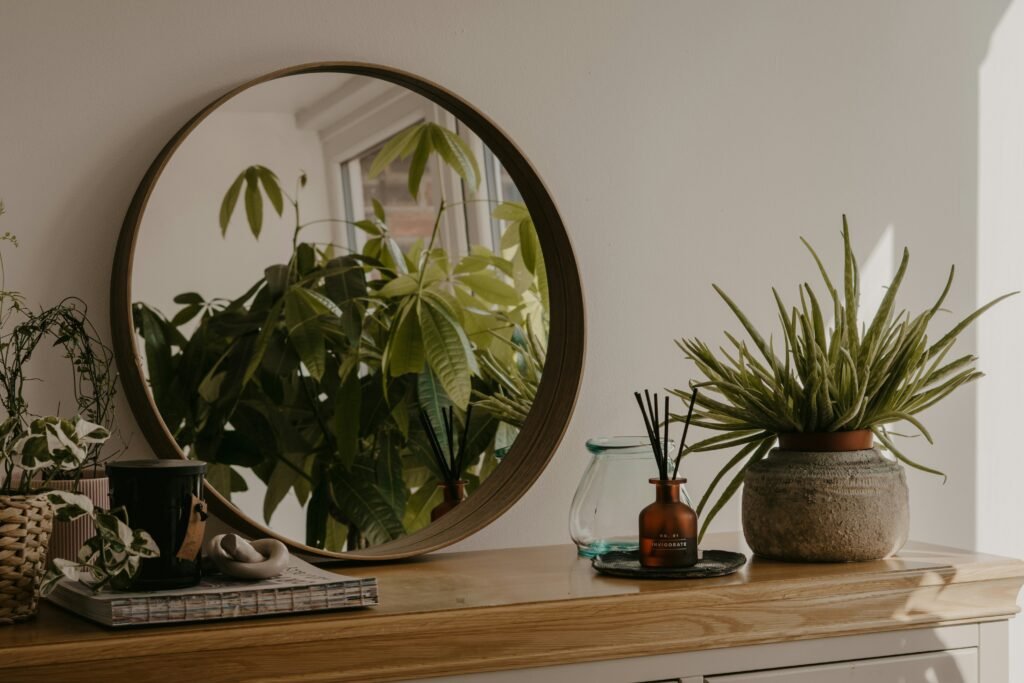
Styling and Design Principles
Plants can serve as design elements. Think about color, texture, height, and repetition to create a cohesive look.
Scale and Proportion
Match the plant size to surrounding furniture. Small plants suit nightstands; medium plants work on shelves; tall plants need open floor space. You want balance so a plant doesn’t overwhelm or get lost.
Grouping and Layering
Group plants in odd numbers—three or five often looks natural. Combine tall plants with short groundcover or trailing plants to create depth. Vary pot heights with stands or stacked books to stagger levels.
Texture and Leaf Shape
Contrast glossy leaves with feathery fronds or large foliaged plants with small-leaf varieties. This contrast gives visual interest and prevents monotony.
Color and Pot Selection
Coordinate pot colors and materials with your bedroom palette. Neutral pots create a cohesive look, while colorful or patterned pots add personality. Use woven baskets, ceramic pots, or metal stands depending on your style.
Minimalist vs. Botanical Maximalist
For a minimalist look, choose a few sculptural plants with clean pots. If you prefer a botanical, layered aesthetic, use multiple plant types, odd-number groupings, and varied containers.
Containers, Soil, and Drainage
Right containers and soil are essential for healthy plants and easy maintenance.
Choosing Pots
Use pots with drainage holes for most plants to avoid root rot. If your pot lacks drainage, add a layer of gravel and be conservative with watering, or use a nursery pot inside a decorative outer pot.
Materials and Effects
Terracotta pots allow soil to dry out faster and suit succulents. Glazed ceramic retains moisture longer and works well for humidity-loving plants. Wicker baskets add organic warmth but should contain a waterproof inner pot.
Soil Mixes
Use potting mix appropriate to the plant: succulents need fast-draining soil; tropical plants prefer peat-based mixes with good moisture retention. Consider adding perlite or pumice to improve drainage.
Self-Watering and Water Reservoirs
Self-watering pots and reservoirs can simplify care, especially if you travel. They prevent overwatering and provide consistent moisture.
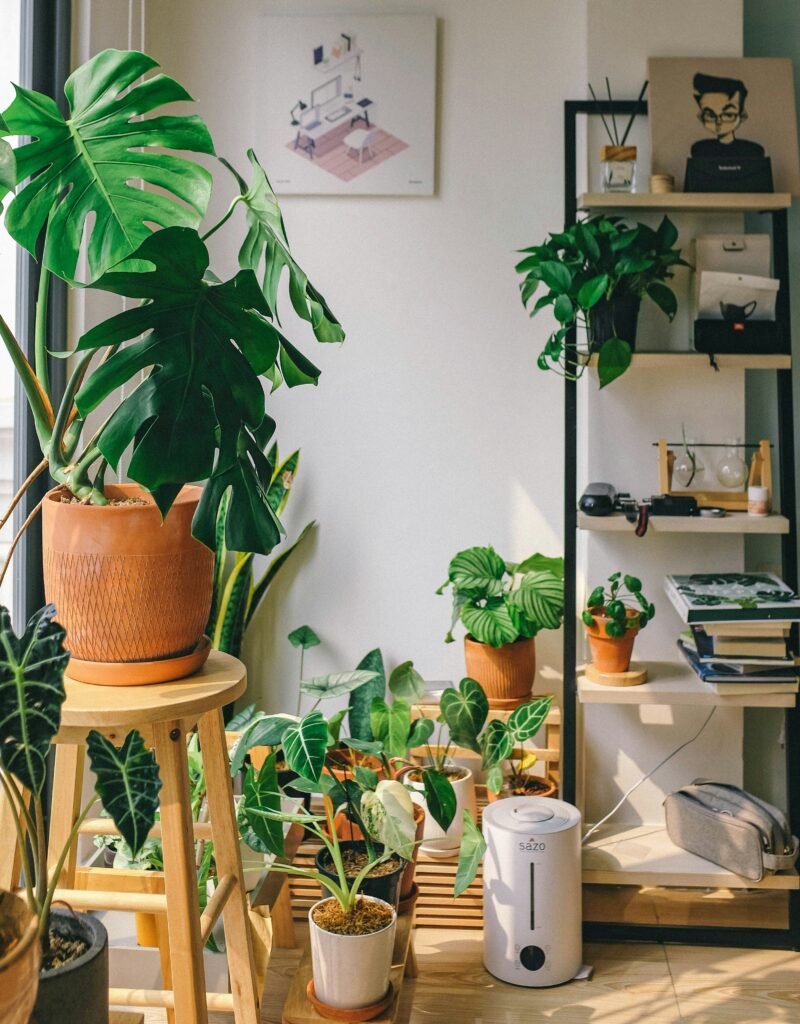
Lighting Solutions and Grow Lights
If your bedroom lacks natural light, you can supplement with artificial lighting so plants thrive.
Types of Grow Lights
LED grow lights are energy-efficient and produce little heat. Full-spectrum LED bars or bulbs simulate natural light and are suitable for most houseplants.
Placement and Timing
Place lights 12–24 inches above plants depending on the light intensity and type. Use a timer to mimic daylight hours—generally 10–14 hours depending on the plant.
Light Intensity Guide
- Low-light plants: 1–2 feet from a small LED or in shady areas with occasional artificial light.
- Medium-light plants: 12–18 inches from a standard LED grow light.
- High-light plants: 6–12 inches from a stronger grow light with direct exposure.
Humidity and Temperature Tips
Many bedroom plants prefer stable temperatures and moderate humidity. You can adjust your room to be more plant-friendly without drastic changes.
How to Increase Humidity
Group plants together, use pebble trays with water, or run a small humidifier. Bathroom-adjacent bedrooms often have higher humidity, which benefits ferns and calatheas.
Temperature Considerations
Most tropical houseplants prefer 65–75°F (18–24°C) during the day and not much lower at night. Avoid placing plants near air vents, heaters, or drafty windows.

Care and Maintenance
Regular care helps plants thrive and keeps your bedroom looking fresh. A simple schedule makes maintenance manageable.
Watering Guidelines
Water based on the plant’s needs and potting mix, not on a strict calendar. Check soil moisture by feeling an inch below the surface for many plants. Succulents and cacti need far less frequent watering.
Fertilizing
Use a balanced houseplant fertilizer during the active growing season (spring and summer). Reduce or stop fertilizing in fall and winter when growth slows.
Pruning and Deadheading
Trim yellow or brown leaves and remove spent flowers to maintain appearance and direct energy to healthy growth. Pinch back leggy stems to encourage bushier growth.
Repotting
Repot when a plant becomes root-bound or when soil quality declines, typically every 1–3 years. Choose a pot 1–2 inches larger in diameter for small-to-medium plants.
Cleaning Leaves
Dust leaves regularly to keep them photosynthesizing efficiently. Wipe larger leaves with a damp cloth and mist smaller-leafed plants when appropriate.
Maintenance Schedule (Example)
| Task | Frequency | Notes |
|---|---|---|
| Check soil moisture | Weekly | More often in hot/dry months |
| Watering | Every 1–2 weeks | Depends on species and pot |
| Fertilizing | Monthly (growing season) | Dilute to half strength if unsure |
| Dusting/wiping leaves | Monthly | More often for dusty rooms |
| Pruning | As needed | Remove dead foliage promptly |
| Repotting | Every 1–3 years | Inspect roots during repotting |
| Pest check | Monthly | Look under leaves and stems |
Pet and Child Safety
If you share your home with pets or children, prioritize non-toxic plants and safe placement.
Non-Toxic Plant Options
Spider plant, areca palm, certain succulents (like haworthia), and pilea are generally considered safer. Always verify with up-to-date sources as plant toxicity information can change.
Toxic Plants to Avoid or Place High
Pothos, philodendron, snake plant, ZZ plant, peace lily, oleander, and many types of lilies are toxic if ingested. Keep these out of reach or avoid them entirely if safety is a priority.
Practical Barriers
Use plant stands, hanging planters out of reach, or create a designated plant corner with barriers to prevent curious pets from accessing pots.
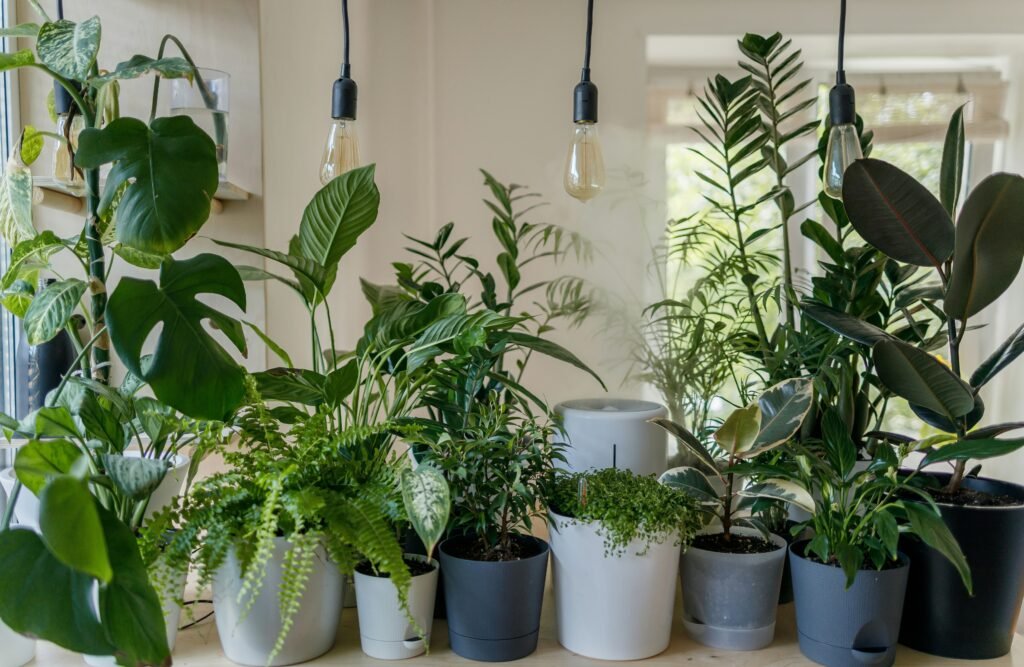
Small Bedroom Ideas
You can make a small bedroom feel larger and greener by thinking vertically and using compact solutions.
Vertical and Wall-Mounted Options
Wall planters, shelves with trailing plants, and hanging pots free up floor space. Use a narrow ladder shelf or floating shelves to display multiple plants.
Multi-Function Furniture
Choose nightstands or shelving units that incorporate space for plants. Use slim stands that hold a plant without taking much floor area.
Vertical Garden Table
A slim plant table or tiered plant stand near a window offers maximum greenery in a small footprint.
Large Bedroom Ideas
In bigger rooms you can create lush, layered plant displays and larger focal points.
Statement Plants
One or two large plants such as a fiddle leaf fig or palms can anchor a seating area or a reading nook. Pair them with complementary mid-sized plants.
Plant Room Dividers
Use taller plants in a row or on stands to create a natural room divider between sleeping and dressing or sitting areas.
Grouped Plant Corners
Create a plant cluster with varying heights, textures, and pot styles for a rich botanical look.
Creative Projects and DIY
Incorporate plants into unique DIY pieces to personalize your bedroom.
Macramé and Hanging Planters
Make or buy macramé hangers to suspend plants at different heights. This adds texture and dimension while saving floor space.
Terrariums and Glass Containers
Closed or open terrariums suit small succulents, air plants, or moisture-loving mosses. They make great bedside accessories when kept small and simple.
Upcycled Containers
Repurpose teacups, tins, or old ceramic dishes as planters after ensuring proper drainage. These add charm and reduce waste.
Wall-Mounted Plant Frames
Create a living art piece with mounted planters or pocket planters. Use light-loving plants and a secure mounting system.
Seasonal Care and Adjustments
Plants’ needs change with the seasons, so adjust light, water, and humidity accordingly.
Winter Care
Reduce watering as growth slows, but ensure humidity for tropical species using trays or humidifiers. Rotate plants occasionally to avoid uneven light exposure from shorter days.
Summer Care
Increase watering when temperatures rise. Watch for pests that become more active with warmth and treat promptly.
Traveling and Vacations
Group plants together, water thoroughly before leaving, and use self-watering pots or reservoirs if you’ll be away for more than a few days.
Troubleshooting Common Problems
Identifying signs early keeps plants healthy. Here are common issues and how you can fix them.
Yellow Leaves
Often caused by overwatering or poor drainage. Check roots and soil; allow soil to dry and improve drainage. Remove heavily affected foliage.
Brown Leaf Tips
Usually due to low humidity, underwatering, or salt build-up from fertilizers. Trim brown tips, flush soil occasionally, and increase humidity if needed.
Leggy Growth
Insufficient light causes stretching. Move the plant to a brighter spot or prune to encourage fuller growth.
Pests
Common pests include spider mites, mealybugs, and scale. Isolate the plant, wipe leaves, use insecticidal soap or neem oil, and repeat treatment weekly until cleared.
Budget-Friendly Ways to Build a Plant Collection
You don’t need to spend a lot to have a thriving plant collection.
Propagation
Many plants are easy to propagate from cuttings—pothos, spider plant, and succulents. You’ll expand your collection at minimal cost.
Plant Swaps and Local Groups
Join local plant swap groups or social media communities where members trade cuttings and plants.
Start Small and Grow
Begin with a few hardy plants and add more as you gain confidence. Buy smaller plants to save money and repot into nicer containers later.
Final Checklist Before You Start
A quick checklist helps you set up a successful bedroom plant scheme.
- Assess light levels and measure spaces
- Choose plants suited to your environment and lifestyle
- Select pots with proper drainage
- Prepare appropriate soil mixes
- Plan placement for aesthetics and safety
- Set a simple maintenance routine
- Arrange humidity or lighting aids if needed
Frequently Asked Questions
You’ll often have quick questions once you start adding plants to your bedroom.
Can I keep a plant on my nightstand?
Yes, as long as it fits the space and won’t drip water on your furniture. Small, low-light plants like pothos or a small snake plant work well—just use a saucer.
Do plants keep you awake?
Some flowering or strongly scented plants could bother sensitive sleepers, but most foliage plants don’t negatively affect sleep. In fact, plants like snake plant and spider plant can improve air quality overnight.
How many plants are too many?
There’s no strict limit. Start with a few and add as you can care for them. Ensure you have time for maintenance and that plants aren’t overcrowded, which can encourage pests.
Are grow lights necessary?
Not always. If your bedroom has sufficient natural light, grow lights aren’t needed. For low-light rooms, a modest LED grow light can support healthier growth.
Closing Tips
Plants can be a joyful, living addition to your bedroom. Start with plants that match your conditions and gradually expand your collection through propagation and mindful purchases. With a little planning and regular care, your bedroom can become a peaceful, plant-filled retreat that feels both personal and rejuvenating.
If you want, tell me your bedroom’s light and space conditions and whether you have pets, and I’ll suggest a tailored plant list and placement plan.
